cooling YAMAHA FX SVHO 2019 Owners Manual
[x] Cancel search | Manufacturer: YAMAHA, Model Year: 2019, Model line: FX SVHO, Model: YAMAHA FX SVHO 2019Pages: 116, PDF Size: 12.33 MB
Page 5 of 116

Table of contents
General and important labels ........... 1
Identification numbers .................... 1
Primary Identification (PRI-ID)
number............................................ 1
Craft Identification Number (CIN) ....... 1
Engine serial number.......................... 1
Manufactured date label .................... 2
Model information ........................... 2
Builder’s plate .................................... 2
Important labels .............................. 4
Warning labels.................................... 5
Other labels ........................................ 8
Safety information ........................... 10
Limitations on who may operate
the watercraft ............................. 10
Cruising limitations ........................ 11
Operation requirements ................ 12
Recommended equipment ........... 14
Hazard information........................ 15
Watercraft characteristics ............. 15
Wakeboarding and water-skiing ... 17
Safe boating rules ......................... 18
Enjoy your watercraft
responsibly ................................. 19
Description....................................... 20
Watercraft glossary ....................... 20
Location of main components ...... 21
Control function operation ............. 25
Watercraft control functions ......... 25
Yamaha Security System ................. 25
Engine stop switch .......................... 26
Engine shut-off switch .................... 26
Start switch ..................................... 26
Throttle lever .................................... 27
RiDE lever ........................................ 27
Steering system ............................... 27
Adjustable tilt steering system ......... 28
Cooling water pilot outlets ............... 29
Water separator................................ 29
Watercraft operation ...................... 30
Watercraft operation functions ..... 30
Shift system ..................................... 30
Electric trim system .......................... 32
Watercraft operation modes ......... 34
Reverse assist .................................. 34
T.D.E. (thrust directional
enhancer) ...................................... 34
No-wake mode ................................. 35
Drive control mode ........................... 36
Cruise assist ..................................... 38
Instrument operation ...................... 40
Multifunction information center ... 40
Operation buttons ............................ 41
Touch screen.................................... 41
Status area ....................................... 42
Home screen ................................... 42
Information screen .......................... 43
Drive control mode screen .............. 44
Setting menu screen ....................... 44
Engine lock screen .......................... 46
Warning function .............................. 46
Equipment operation ...................... 49
Equipment..................................... 49
Seats ................................................ 49
Handgrip........................................... 50
Reboarding grip................................ 50
Reboarding step ............................... 50
Bow eye............................................ 51
Stern eyes ........................................ 51
Cleat ................................................. 51
Pull-up cleats (FX Cruiser SVHO /
FX Limited SVHO) ......................... 52
Storage compartments .................... 52
Fire extinguisher holder and cover ... 56
Optional part mounting bracket ....... 56
Operation and handling
requirements ................................... 57
Fuel requirements ......................... 57
Fuel................................................... 57
UF3X70E0.book Page 1 Friday, August 24, 2018 9:23 AM
Page 6 of 116

Table of contents
Engine oil requirements ................ 59
Engine oil .......................................... 59
Draining the bilge water ................ 60
Draining the bilge water on land ...... 60
Draining the bilge water on water .... 61
Transporting on a trailer ................ 62
First-time operation ........................ 63
Engine break-in ............................. 63
Pre-operation checks ..................... 64
Pre-operation checklist .................... 64
Pre-operation check points........... 66
Pre-launch checks ........................... 66
Post-launch checks ......................... 72
Operation ......................................... 74
Operating your watercraft ............. 74
Getting to know your watercraft ...... 74
Learning to operate your
watercraft ...................................... 74
Riding position ................................. 75
Launching the watercraft ................. 75
Starting the engine on water ............ 75
Stopping the engine ......................... 76
Leaving the watercraft...................... 76
Operating the watercraft .................. 76
Turning the watercraft ...................... 77
Stopping the watercraft ................... 78
Operating the watercraft in reverse
or neutral ...................................... 79
Boarding the watercraft ................... 80
Starting off........................................ 82
Capsized watercraft ......................... 83
Beaching and docking the
watercraft ...................................... 84
Operating in weeded areas .............. 84
After removing the watercraft from
the water ....................................... 85
Care and storage............................. 86
Post-operation care ...................... 86
Flushing the cooling water
passages....................................... 86Cleaning the watercraft .................... 87
Battery care ...................................... 87
Long-term storage ........................ 90
Cleaning ........................................... 90
Lubrication ....................................... 90
Rustproofing ..................................... 90
Maintenance .................................... 91
Maintenance ................................. 91
Tool kit.............................................. 91
Removing and installing the engine
cover ............................................. 91
Periodic maintenance chart ............. 93
Engine oil and oil filter ...................... 95
Specifications .................................. 96
Specifications ............................... 96
Trouble recovery ............................. 97
Troubleshooting ............................ 97
Troubleshooting chart ...................... 97
Emergency procedures .............. 100
Cleaning the jet intake and
impeller ....................................... 100
Raising the reverse gate ................ 101
Jumping the battery ....................... 101
Replacing the fuses ........................ 102
Towing the watercraft..................... 104
Submerged watercraft ................... 104
Index............................................... 106
UF3X70E0.book Page 2 Friday, August 24, 2018 9:23 AM
Page 27 of 116
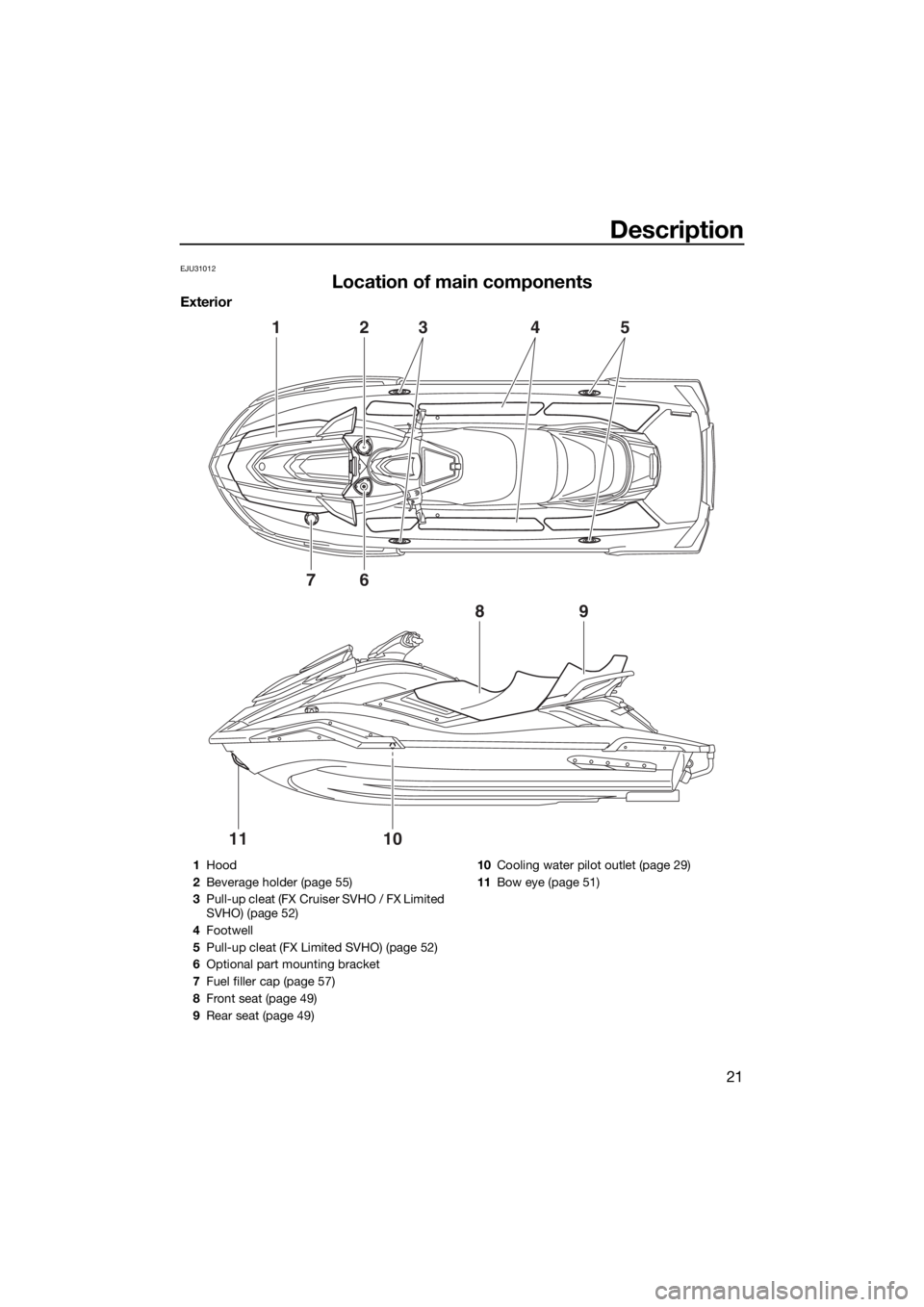
Description
21
EJU31012
Location of main components
Exterior
1
7
89
1011
6
2345
1Hood
2Beverage holder (page 55)
3Pull-up cleat (FX Cruiser SVHO / FX Limited
SVHO) (page 52)
4Footwell
5Pull-up cleat (FX Limited SVHO) (page 52)
6Optional part mounting bracket
7Fuel filler cap (page 57)
8Front seat (page 49)
9Rear seat (page 49)10Cooling water pilot outlet (page 29)
11Bow eye (page 51)
UF3X70E0.book Page 21 Friday, August 24, 2018 9:23 AM
Page 35 of 116
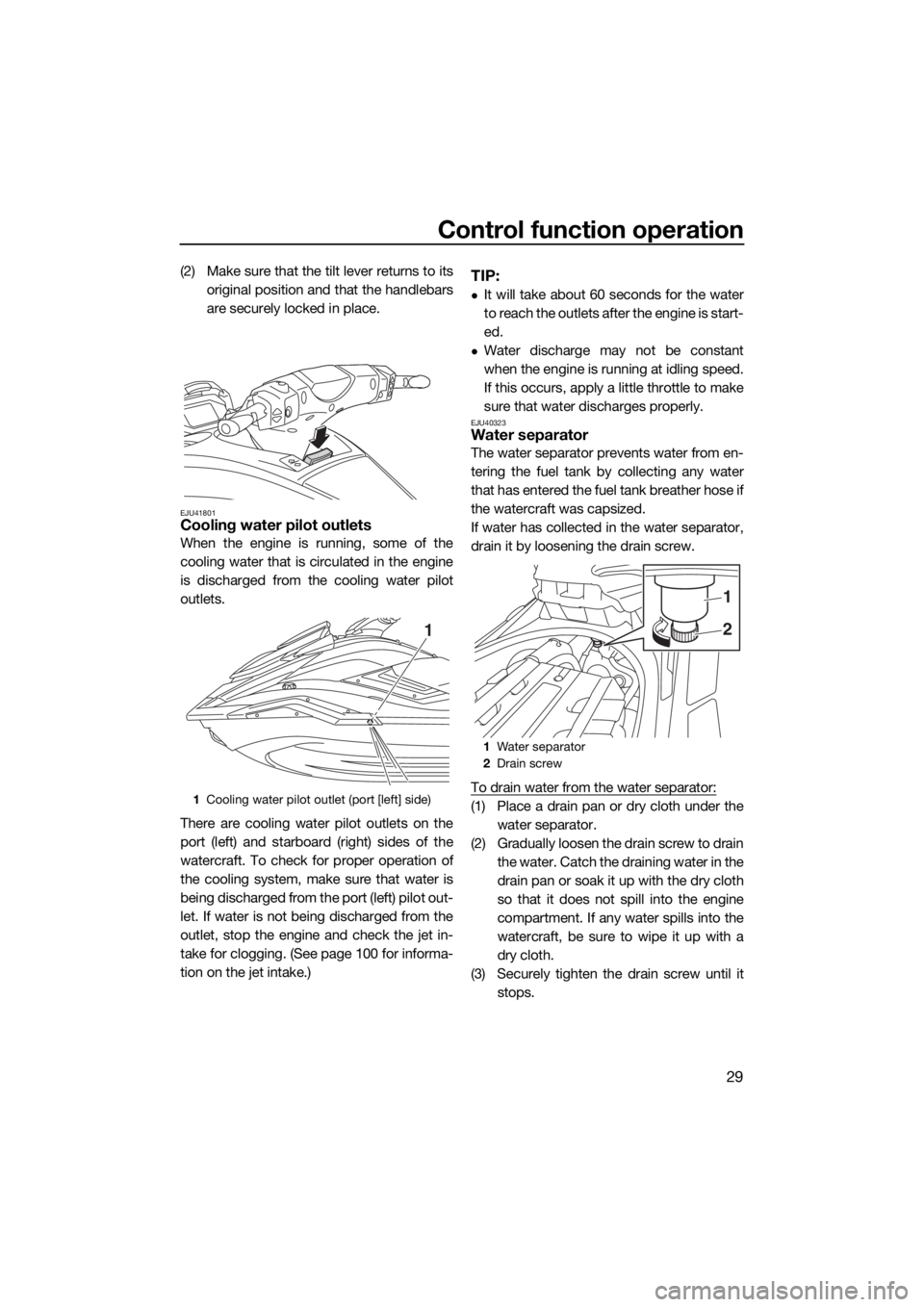
Control function operation
29
(2) Make sure that the tilt lever returns to its
original position and that the handlebars
are securely locked in place.
EJU41801Cooling water pilot outlets
When the engine is running, some of the
cooling water that is circulated in the engine
is discharged from the cooling water pilot
outlets.
There are cooling water pilot outlets on the
port (left) and starboard (right) sides of the
watercraft. To check for proper operation of
the cooling system, make sure that water is
being discharged from the port (left) pilot out-
let. If water is not being discharged from the
outlet, stop the engine and check the jet in-
take for clogging. (See page 100 for informa-
tion on the jet intake.)
TIP:
It will take about 60 seconds for the water
to reach the outlets after the engine is start-
ed.
Water discharge may not be constant
when the engine is running at idling speed.
If this occurs, apply a little throttle to make
sure that water discharges properly.
EJU40323Water separator
The water separator prevents water from en-
tering the fuel tank by collecting any water
that has entered the fuel tank breather hose if
the watercraft was capsized.
If water has collected in the water separator,
drain it by loosening the drain screw.
To drain water from the water separator:
(1) Place a drain pan or dry cloth under the
water separator.
(2) Gradually loosen the drain screw to drain
the water. Catch the draining water in the
drain pan or soak it up with the dry cloth
so that it does not spill into the engine
compartment. If any water spills into the
watercraft, be sure to wipe it up with a
dry cloth.
(3) Securely tighten the drain screw until it
stops.1Cooling water pilot outlet (port [left] side)
1
1Water separator
2Drain screw
2
1
UF3X70E0.book Page 29 Friday, August 24, 2018 9:23 AM
Page 54 of 116
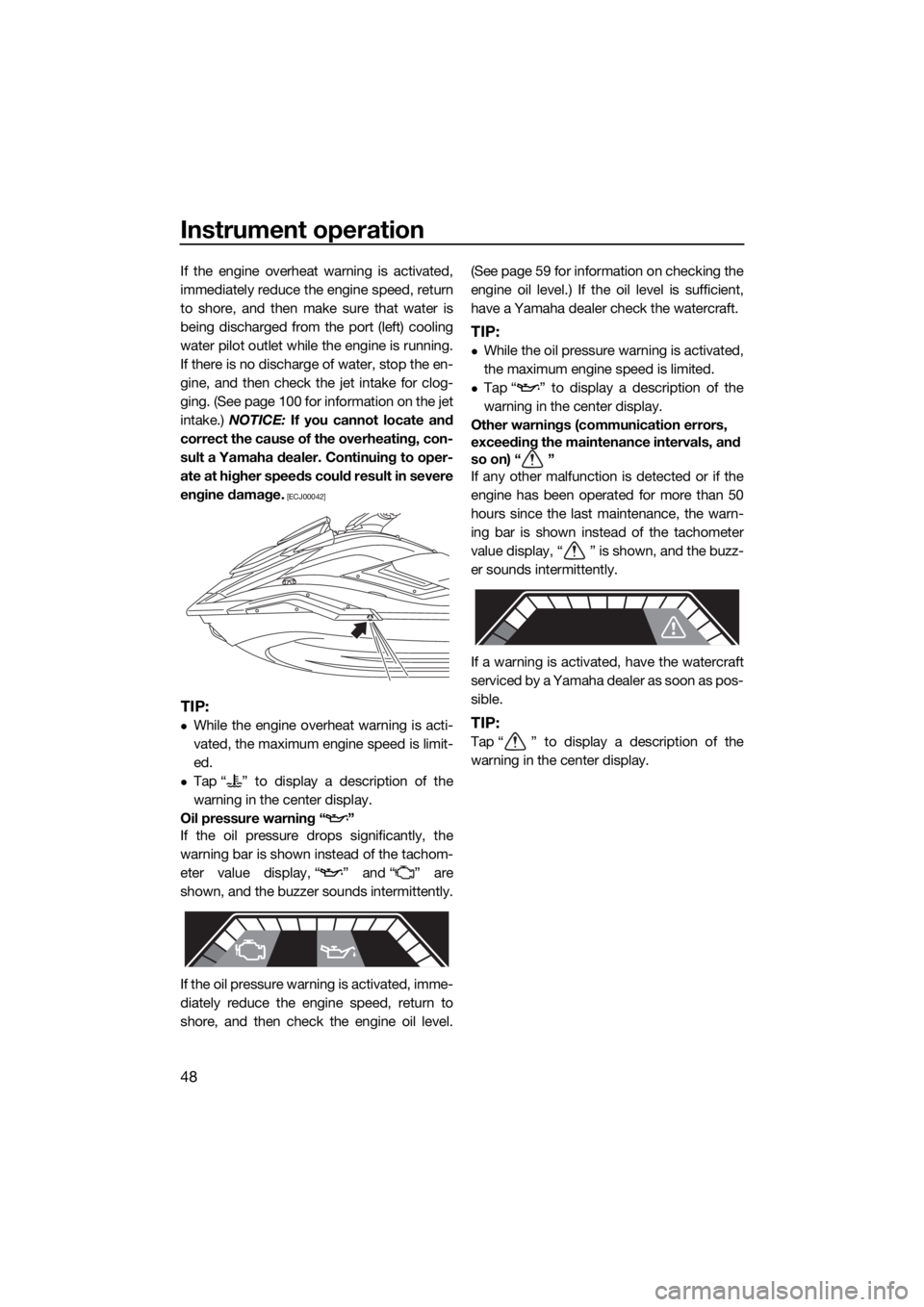
Instrument operation
48
If the engine overheat warning is activated,
immediately reduce the engine speed, return
to shore, and then make sure that water is
being discharged from the port (left) cooling
water pilot outlet while the engine is running.
If there is no discharge of water, stop the en-
gine, and then check the jet intake for clog-
ging. (See page 100 for information on the jet
intake.) NOTICE: If you cannot locate and
correct the cause of the overheating, con-
sult a Yamaha dealer. Continuing to oper-
ate at higher speeds could result in severe
engine damage.
[ECJ00042]
TIP:
While the engine overheat warning is acti-
vated, the maximum engine speed is limit-
ed.
Tap “ ” to display a description of the
warning in the center display.
Oil pressure warning “ ”
If the oil pressure drops significantly, the
warning bar is shown instead of the tachom-
eter value display, “ ” and “ ” are
shown, and the buzzer sounds intermittently.
If the oil pressure warning is activated, imme-
diately reduce the engine speed, return to
shore, and then check the engine oil level.(See page 59 for information on checking the
engine oil level.) If the oil level is sufficient,
have a Yamaha dealer check the watercraft.
TIP:
While the oil pressure warning is activated,
the maximum engine speed is limited.
Tap “ ” to display a description of the
warning in the center display.
Other warnings (communication errors,
exceeding the maintenance intervals, and
so on) “ ”
If any other malfunction is detected or if the
engine has been operated for more than 50
hours since the last maintenance, the warn-
ing bar is shown instead of the tachometer
value display, “ ” is shown, and the buzz-
er sounds intermittently.
If a warning is activated, have the watercraft
serviced by a Yamaha dealer as soon as pos-
sible.
TIP:
Tap “ ” to display a description of the
warning in the center display.
UF3X70E0.book Page 48 Friday, August 24, 2018 9:23 AM
Page 71 of 116

Pre-operation checks
65
TIP:
To ensure safety and reliability, pre-operation checks should be made each time the water-
craft is used.
Jet thrust nozzle and re-
verse gate Check the jet thrust nozzle and reverse gate for
damage.71
Stern drain plugsCheck the stern drain plugs for damage and foreign
material and check that they are securely installed.72
HoodCheck that the hood is securely closed. 72
Front and rear seatsCheck that the seats are securely installed. 49
POST-LAUNCH CHECKS
Cooling water pilot outletCheck that water is discharged from the port (left)
cooling water pilot outlet while the engine is run-
ning.73
Multifunction information
centerCheck the multifunction information center for prop-
er operation.73
Shift system Check the shift system for proper operation. 73
Engine idling speedCheck the engine idling speed. 73 ITEM ROUTINE PAGE
UF3X70E0.book Page 65 Friday, August 24, 2018 9:23 AM
Page 79 of 116
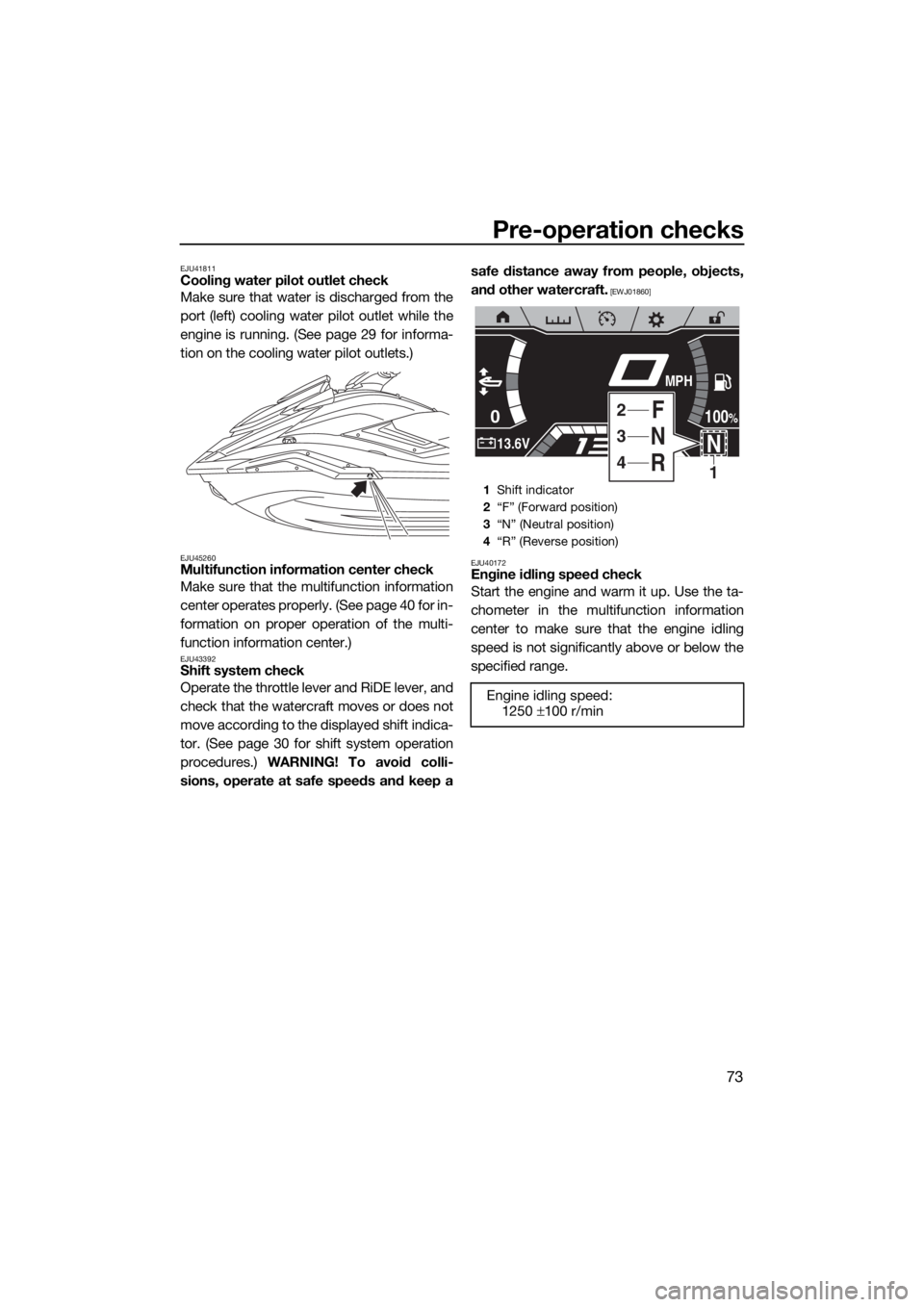
Pre-operation checks
73
EJU41811Cooling water pilot outlet check
Make sure that water is discharged from the
port (left) cooling water pilot outlet while the
engine is running. (See page 29 for informa-
tion on the cooling water pilot outlets.)
EJU45260Multifunction information center check
Make sure that the multifunction information
center operates properly. (See page 40 for in-
formation on proper operation of the multi-
function information center.)
EJU43392Shift system check
Operate the throttle lever and RiDE lever, and
check that the watercraft moves or does not
move according to the displayed shift indica-
tor. (See page 30 for shift system operation
procedures.) WARNING! To avoid colli-
sions, operate at safe speeds and keep asafe distance away from people, objects,
and other watercraft.
[EWJ01860]
EJU40172
Engine idling speed check
Start the engine and warm it up. Use the ta-
chometer in the multifunction information
center to make sure that the engine idling
speed is not significantly above or below the
specified range.
1Shift indicator
2“F” (Forward position)
3“N” (Neutral position)
4“R” (Reverse position)
Engine idling speed:
1250 ±100 r/min
0
N13.6Vx100
RPM
100%
MPH
R NF4
3
2
1
UF3X70E0.book Page 73 Friday, August 24, 2018 9:23 AM
Page 91 of 116

Operation
85
EJU40242After removing the watercraft from
the water
NOTICE
ECJ01311
Do not run the engine over 4000 r/min on
land. Also, do not run the engine for more
than 15 seconds without supplying water,
otherwise the engine could overheat.
After operating and removing the watercraft
from the water, promptly discharge the re-
maining water from the cooling water pas-
sages.
To discharge water from the cooling water
passages:
(1) Make sure that the area around the wa-
tercraft is clear, and then start the en-
gine.
(2) Discharge the remaining water out of the
cooling water passages by alternately
squeezing and releasing the throttle lever
quickly for 10 to 15 seconds.
(3) Stop the engine.
UF3X70E0.book Page 85 Friday, August 24, 2018 9:23 AM
Page 92 of 116
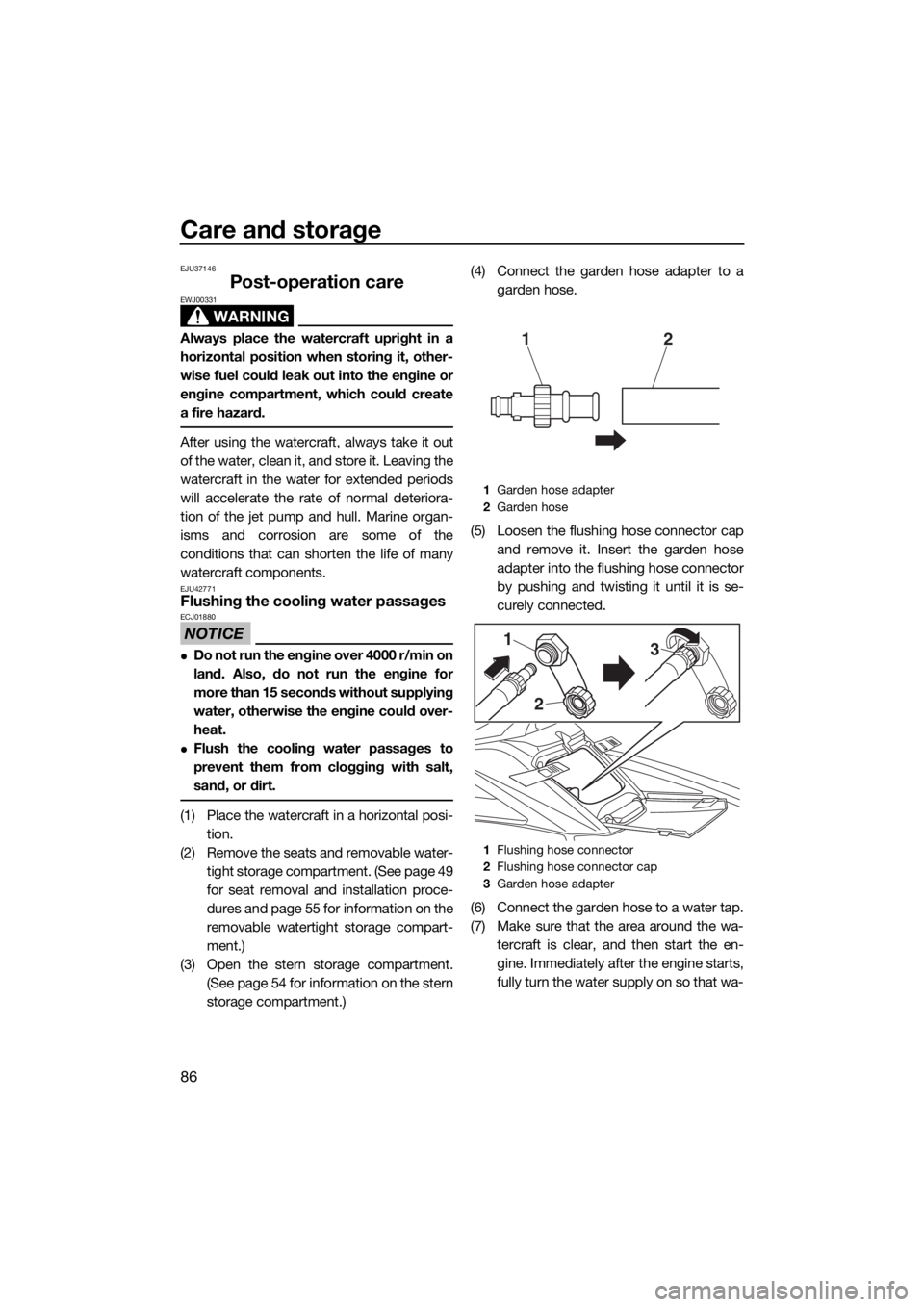
Care and storage
86
EJU37146
Post-operation care
WARNING
EWJ00331
Always place the watercraft upright in a
horizontal position when storing it, other-
wise fuel could leak out into the engine or
engine compartment, which could create
a fire hazard.
After using the watercraft, always take it out
of the water, clean it, and store it. Leaving the
watercraft in the water for extended periods
will accelerate the rate of normal deteriora-
tion of the jet pump and hull. Marine organ-
isms and corrosion are some of the
conditions that can shorten the life of many
watercraft components.
EJU42771Flushing the cooling water passages
NOTICE
ECJ01880
Do not run the engine over 4000 r/min on
land. Also, do not run the engine for
more than 15 seconds without supplying
water, otherwise the engine could over-
heat.
Flush the cooling water passages to
prevent them from clogging with salt,
sand, or dirt.
(1) Place the watercraft in a horizontal posi-
tion.
(2) Remove the seats and removable water-
tight storage compartment. (See page 49
for seat removal and installation proce-
dures and page 55 for information on the
removable watertight storage compart-
ment.)
(3) Open the stern storage compartment.
(See page 54 for information on the stern
storage compartment.)(4) Connect the garden hose adapter to a
garden hose.
(5) Loosen the flushing hose connector cap
and remove it. Insert the garden hose
adapter into the flushing hose connector
by pushing and twisting it until it is se-
curely connected.
(6) Connect the garden hose to a water tap.
(7) Make sure that the area around the wa-
tercraft is clear, and then start the en-
gine. Immediately after the engine starts,
fully turn the water supply on so that wa-
1Garden hose adapter
2Garden hose
1Flushing hose connector
2Flushing hose connector cap
3Garden hose adapter
12
2 1
3
UF3X70E0.book Page 86 Friday, August 24, 2018 9:23 AM
Page 93 of 116
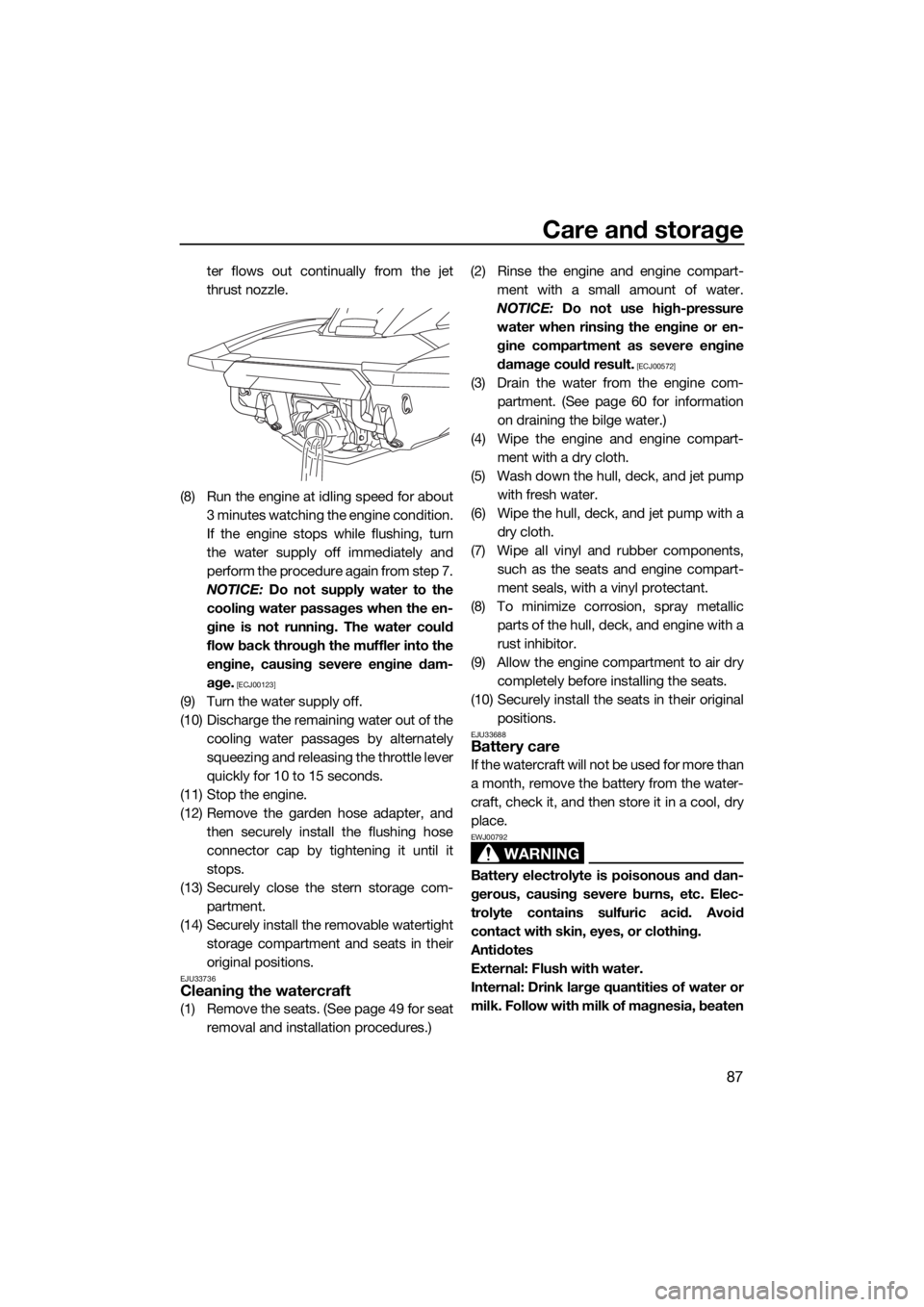
Care and storage
87
ter flows out continually from the jet
thrust nozzle.
(8) Run the engine at idling speed for about
3 minutes watching the engine condition.
If the engine stops while flushing, turn
the water supply off immediately and
perform the procedure again from step 7.
NOTICE: Do not supply water to the
cooling water passages when the en-
gine is not running. The water could
flow back through the muffler into the
engine, causing severe engine dam-
age.
[ECJ00123]
(9) Turn the water supply off.
(10) Discharge the remaining water out of the
cooling water passages by alternately
squeezing and releasing the throttle lever
quickly for 10 to 15 seconds.
(11) Stop the engine.
(12) Remove the garden hose adapter, and
then securely install the flushing hose
connector cap by tightening it until it
stops.
(13) Securely close the stern storage com-
partment.
(14) Securely install the removable watertight
storage compartment and seats in their
original positions.
EJU33736Cleaning the watercraft
(1) Remove the seats. (See page 49 for seat
removal and installation procedures.)(2) Rinse the engine and engine compart-
ment with a small amount of water.
NOTICE: Do not use high-pressure
water when rinsing the engine or en-
gine compartment as severe engine
damage could result.
[ECJ00572]
(3) Drain the water from the engine com-
partment. (See page 60 for information
on draining the bilge water.)
(4) Wipe the engine and engine compart-
ment with a dry cloth.
(5) Wash down the hull, deck, and jet pump
with fresh water.
(6) Wipe the hull, deck, and jet pump with a
dry cloth.
(7) Wipe all vinyl and rubber components,
such as the seats and engine compart-
ment seals, with a vinyl protectant.
(8) To minimize corrosion, spray metallic
parts of the hull, deck, and engine with a
rust inhibitor.
(9) Allow the engine compartment to air dry
completely before installing the seats.
(10) Securely install the seats in their original
positions.
EJU33688Battery care
If the watercraft will not be used for more than
a month, remove the battery from the water-
craft, check it, and then store it in a cool, dry
place.
WARNING
EWJ00792
Battery electrolyte is poisonous and dan-
gerous, causing severe burns, etc. Elec-
trolyte contains sulfuric acid. Avoid
contact with skin, eyes, or clothing.
Antidotes
External: Flush with water.
Internal: Drink large quantities of water or
milk. Follow with milk of magnesia, beaten
UF3X70E0.book Page 87 Friday, August 24, 2018 9:23 AM